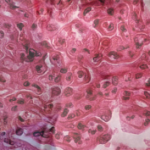Dr. Appenzeller also shared some complementary findings of a study showing histologic changes in repeated renal biopsies at diagnosis and consequent treatment of lupus nephritis. Higher inflammatory type lesions—characterized by neutrophils, fibrinoid necrosis and cellular crescents—usually resolve completely during initial immunosuppression, she said. Standard-of-care treatment, including high-dose glucocorticoids, tends to work well for patients with such lesions.12
However, other lesions tend to persist with standard-of-care therapy, although at lower levels, in 50–60% of patients after eight to nine months of treatment. Many patients had other histological lesions even longer, especially hyaline deposits, glomerular crescents and tubulointerstitial inflammation. Such lesions often appear to take months or years to resolve, supporting the current use of long-term maintenance therapy in many patients.12
 Ruth Jessen Hickman, MD, a graduate of the Indiana University School of Medicine, is a medical and science writer in Bloomington, Ind.
Ruth Jessen Hickman, MD, a graduate of the Indiana University School of Medicine, is a medical and science writer in Bloomington, Ind.
References
- Groot N, de Graeff N, Avcin T, et al. European evidence-based recommendations for the diagnosis and treatment of childhood-onset lupus nephritis: The SHARE initiative. Ann Rheum Dis. 2017 Nov;76(12):1788–1796.
- Alforaih N, Whittall-Garcia L, Touma Z. A review of lupus nephritis. J Appl Lab Med. 2022 Oct;7(6):1450–1467.
- Palazzo L, Lindblom J, Mohan C, Parodis I. Current insights on biomarkers in lupus nephritis: A systematic review of the literature. J Clin Med. 2022 Sep;11(19):5759.
- De Mutiis C, Wenderfer SE, Basu B, et al. International cohort of 382 children with lupus nephritis—Presentation, treatment and outcome at 24 months. Pediatr Nephrol. 2023 Nov;38(11):3699–3709.
- Smith EMD, Aggarwal A, Ainsworth J, et al. Towards development of treat to target (T2T) in childhood-onset systemic lupus erythematosus: PReS-endorsed overarching principles and points-to-consider from an international task force. Ann Rheum Dis. 2023 Jun;82(6):788–798.
- Kidney Disease: Improving Global Outcomes (KDIGO) Lupus Nephritis Work Group. KDIGO 2024 clinical practice guideline for the management of lupus nephritis. Kidney Int. 2024 Jan;105(1S):S1–S69.
- Hahn BH, McMahon MA, Wilkinson A, et al. American College of Rheumatology guidelines for screening, treatment, and management of lupus nephritis. Arthritis Care Res (Hoboken). 2012 Jun;64(6):797–808.
- Sammaritano L, Askanase A, Bermas BL, et al. 2024 American College of Rheumatology (ACR) Guideline for the Screening, Treatment, and Management of Lupus Nephritis. Arthritis Rheumatol. 2025. Online ahead of print.
- De Rosa M, Rocha AS, De Rosa G, et al. Low-grade proteinuria does not exclude significant kidney injury in lupus nephritis. Kidney Int Rep. 2020 Apr;5(7):1066–1068.
- Stokes MB, D’Agati VD. Classification of lupus nephritis; Time for a change? Adv Chronic Kidney Des. 2019 Sep;26(5):323–329.
- Malvar A, Alberton V, Lococo B, et al. Kidney biopsy-based management of maintenance immunosuppression is safe and may ameliorate flare rate in lupus nephritis. Kidney Int. 2020 Jan;97(1):156–162.
- Malvar A, Alberton V, Lococo B, et al. Remission of lupus nephritis: The trajectory of histological response in successfully treated patients. Lupus Sci Med. 2023 May;10(1):e000932.


